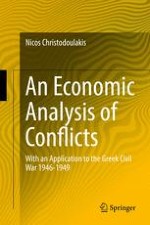2016 | OriginalPaper | Buchkapitel
7. A Model of Intertemporal Conflict
verfasst von : Nicos Christodoulakis
Erschienen in: An Economic Analysis of Conflicts
Aktivieren Sie unsere intelligente Suche, um passende Fachinhalte oder Patente zu finden.
Wählen Sie Textabschnitte aus um mit Künstlicher Intelligenz passenden Patente zu finden. powered by
Markieren Sie Textabschnitte, um KI-gestützt weitere passende Inhalte zu finden. powered by
